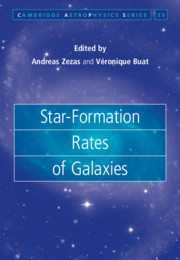Book contents
- Frontmatter
- Contents
- List of Figures
- List of Tables
- List of Contributors
- Preface
- Part I Background
- Part II SFR Measurements
- 5 Star-Formation Rates from Resolved Stellar Populations
- 6 Star-Formation Measurements in Nearby Galaxies
- 7 Continuum and Emission-Line Star-Formation Rate Indicators
- 8 Star-Formation Rates from Spectral Energy Distributions of Galaxies
- 9 Modelling the Spectral Energy Distribution of Star-Forming Galaxies with Radiative Transfer Methods
- 10 Measuring the Star-Formation Rate in Active Galactic Nuclei
- 11 High-Energy Star-Formation Rate Indicators
- Index
8 - Star-Formation Rates from Spectral Energy Distributions of Galaxies
from Part II - SFR Measurements
Published online by Cambridge University Press: 11 May 2021
- Frontmatter
- Contents
- List of Figures
- List of Tables
- List of Contributors
- Preface
- Part I Background
- Part II SFR Measurements
- 5 Star-Formation Rates from Resolved Stellar Populations
- 6 Star-Formation Measurements in Nearby Galaxies
- 7 Continuum and Emission-Line Star-Formation Rate Indicators
- 8 Star-Formation Rates from Spectral Energy Distributions of Galaxies
- 9 Modelling the Spectral Energy Distribution of Star-Forming Galaxies with Radiative Transfer Methods
- 10 Measuring the Star-Formation Rate in Active Galactic Nuclei
- 11 High-Energy Star-Formation Rate Indicators
- Index
Summary
Addressing the question of the formation and the evolution of galaxies in a cosmological context implies that we must understand their emission over the broadest electromagnetic spectrum. Using multi-wavelength data consistently enables to measure reliable physical parameters like star-formation rates and stellar masses.However, the drawback of this approach is that we do need more information in terms of data. We also need to handle them by using powerful computers and smart codes that are able to run ina reasonable amount of time and deal with a wealth of data and a huge number of models. A statistical approach is also mandatory to estimate the reliability of the results. In this chapter I will describe the different components and physical processesthat leave their imprints in the distribution of energy of galaxiesandhow physicalparameters related to their star formation history can be extracted from the fit of their spectral energy distribution. I willpresent physically-motivated codes which assume an energy balance between dust stellar absorption and re-emission
- Type
- Chapter
- Information
- Star-Formation Rates of Galaxies , pp. 184 - 203Publisher: Cambridge University PressPrint publication year: 2021

